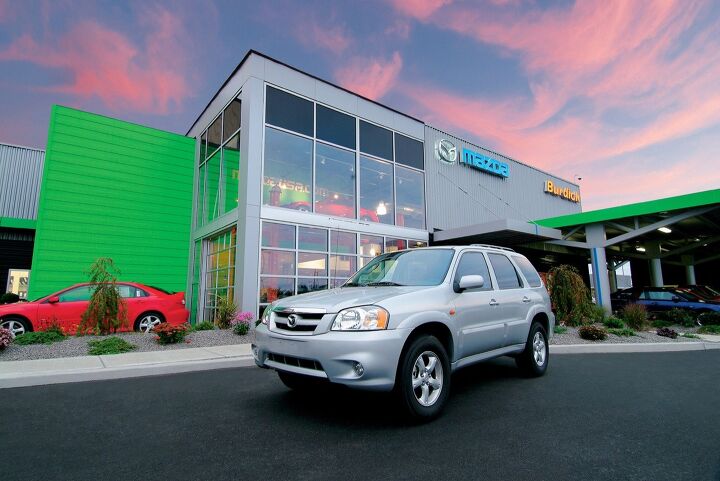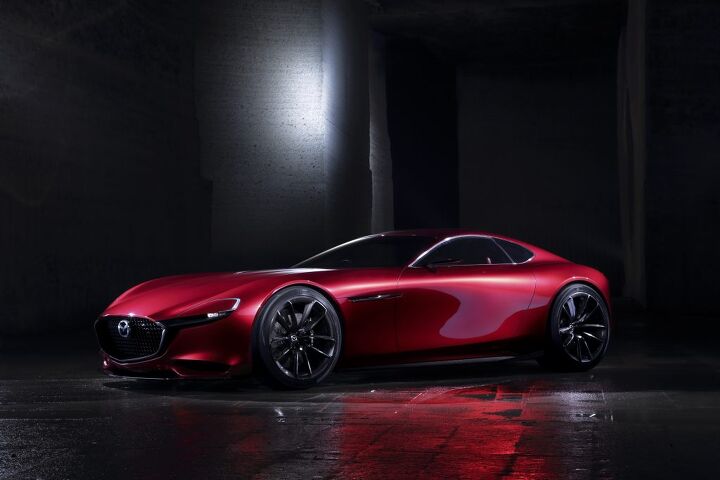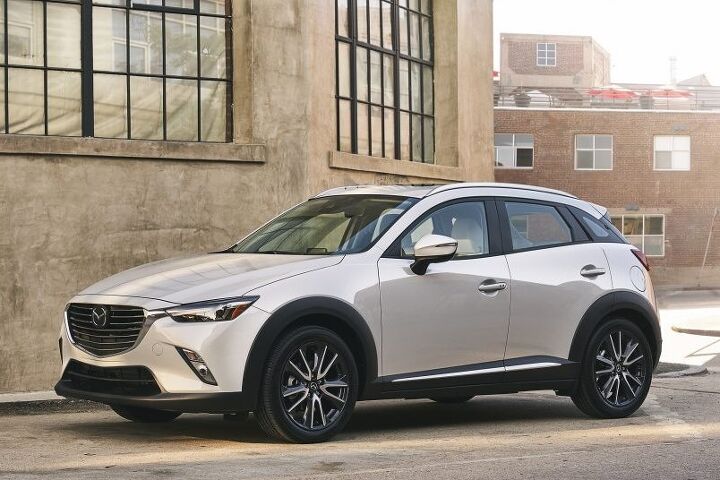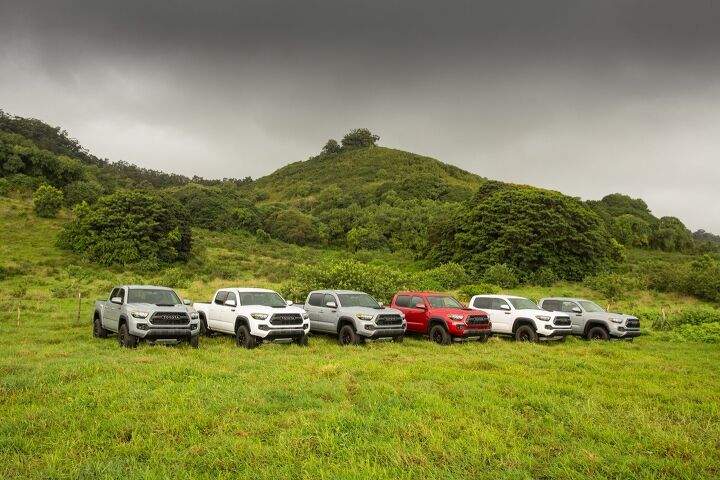#Mazda
We Still Don't Know When the Mazda CX-5 Diesel Will Arrive in America
The potential for success is limited, but Mazda nevertheless announced in Los Angeles in November 2016 that the revamped 2017 Mazda CX-5 would be available with a 2.2-liter diesel torque monster.
Diesel? 2017? The Volkswagen diesel emissions scandal that broke in late 2015 ended diesel’s run at Volkswagen of America and eventually ended with the withdrawal of diesel engines in Mercedes-Benz USA’s lineup, as well.
Yet diesel persists. General Motors, for example, is selling diesel variants of the Chevrolet Cruze and Equinox and the Equinox’s GMC Terrain sibling. And with Mazda’s decision to sell a 310-lb-ft diesel CX-5, compact crossover shoppers would have three choices.
Mazda said last year that “it will offer the Skyactiv-D 2.2 clean diesel engine in the all-new Mazda CX-5 for North America from the second half of 2017.”
Only half of the second half remains, and MazdaUSA.com still lists the 2017 CX-5 Diesel as a future vehicle. So where’s the 2017 Mazda CX-5 Diesel we were promised?
2004 Mazda MX-5 Miata Long-Term Update: Late September Is Convertible Season
Mrs. Cain is taking the littlest boy to a baby shower. I’ve got the older boy, a car-loving three-year-old who’s been pleading for a trip to the ice cream barn for days.
I take the car seat out of our Honda Odyssey and am presented with a choice. For roughly 40 minutes of evening driving from Margate to Schurmans Point, around Summerside, and back home, do we take the 2018 Mercedes-Benz E400 4Matic Coupe with its massaging seats and Burmester audio? Or do we opt for our 2004 Mazda MX-5 Miata? It’s fall in Canada, but the heat wave experienced by much of the continent has presented us with a lovely day. Granted, the evening temperature is fast falling, and the boy has a runny nose.
It’s snot a difficult choice to make. The roof goes down, his window stays up, the heater cranks up, the garage door goes down, and we’re off for a father-son bonding session in the best car in the world.
Mazda6 Recalled Over Power Steering Short and Shoddy Welding
Mazda has announced a recall of roughly 58,000 Mazda6 sedans in the United States and Canada. The cars in question were produced between November 3rd of 2014 and December 9th of 2015 and guilty of some shoddy welding. Cars from the 2015 and 2016 model years could have wires under the front passenger seat rubbing against welding debris, running the risk of an electrical short.
The end result is a dashboard plagued with warning lights and, in some instances, the loss of power steering. Shorting can also run the risk of disabling the airbag. Mazda has decided to conduct a voluntary safety recall even though it says the warning light illumination is in full compliance with Federal Motor Vehicle Safety Standards.
Mazda Plans U.S. Dealer Network Makeover, Still Wants 2-percent Market Share (and More CX-5s)
“We have been working more closely with our dealers to evolve their businesses and through that process,” Mazda tells Automotive News, “some new dealers have chosen to begin working with us, while others have made the decision to leave the Mazda brand.”
Mazda has been open about its goal of earning 2 percent of the U.S. market while being forthright about the brand’s intentions to do so only on solid ground. This means fewer discounts, a premium vibe, and the kind of higher margins that make dealers happy.
On the dealer side of the equation, Mazda now wants those dealers to improve. In some cases, that means a new location. In others, a new exterior design is necessary. More thoroughly trained staff members is key, as well. But it’ll be slow going. Of Mazda’s roughly 600 dealers, the brand acknowledges that some have forsaken the automaker, though Mazda won’t say how many. Since the efforts to revamp dealers began last year, only 26 have been upgraded so far. By the end of the decade, Mazda believes roughly one-sixth of its network will have undergone a remodel.
In the meantime, Mazda is getting further away from reaching its 2-percent goal.
More Internal Combustion Abandonment: Mazda Plans Fully Electric Fleet By 'Early 2030s'
Mazda recently announced the testing of its Skyactiv-X compression ignition engine, which promises to burn gasoline with diesel-like efficiency. If it hits its projected launch date of 2019, it will become the first mass-produced motor of its type and is likely to be showered with praise from environmentalists and enthusiasts alike.
However, as we progress deeper into the millennium, it’s becoming evident that more and more automakers are willing to embrace electricity as the next solution to efficiency. That makes Mazda a bit of an oddity, maybe even a dinosaur, and we were wondering when the company would give in to electrification. Especially since it has already partnered with Toyota to tighten its grasp on the technology.
We'll Tell You One More Time: The Mazda CX-8 Is Not Coming to America
We’ve told you before. Now, with the Mazda CX-8 making its proper debut, we’ll tell you one more time after yet more confirmation from Mazda.
The Mazda CX-8 is not coming to America.
Mazda has its reasons.
At Least Partially, One of the Mazda CX-9's Key Faults Is Fixed for 2018
It was a tidbit easy to skip over, a tacked-on phrase designed to illicit nary a response, a drip-drip-drip of information without the two latter drips. In Mazda’s press release announcing the addition of more safety equipment to the base Sport model of the 2018 Mazda CX-9, the company briefly made mention of a reconfigured passenger compartment.
“Among the highlights are more features at every price point,” Mazda says, “such as an improved second row for both greater comfort and easier third-row access and greater sound insulation in what is already one of the quietest vehicles in its class.”
An improved second row? Easier third row access? Of all the things the second-generation Mazda CX-9 required, those elements would certainly rank near the top of the list. But is this just a fanciful claim, or did Mazda actually make meaningful changes to the CX-9 less than a year and a half into its lifecycle?
We have answers.
2018 Mazda CX-9 Gets More Expensive, With Reason, but Will Consumers Pay Up?
Mazda is increasing the base price of its CX-9 flagship by $610 for the 2018 model year.
With more standard safety kit, Mazda’s $32,460 2017 CX-9 (after delivery) now becomes the $33,070 2018 Mazda CX-9.
But can Mazda, which sells the CX-9 at a slower rate than essentially all of its competitors, operate at an even higher price point? The second-generation Mazda CX-9 was already priced at a premium: $775 more than Pilot, $835 more than Highlander, $1,210 more than Pathfinder, $1,370 more than Durango, $1,585 more than the 2018 Traverse.
Mazda doesn’t seem terribly bothered. The majority of CX-9s sold in America are already top-spec Grand Touring and Signature models, higher-margin vehicles that are helping Mazda slowly craft an image as a premium mainstream brand, buoyed along by Driver’s Choice commercials and, as we can see now, CX-9s with $33,070 base MSRPs.
2018 Mazda CX-3 Is Better, But Until It's Bigger, Better Probably Isn't Good Enough
Accompanied by a modest price increase of $150, Mazda’s first-generation CX-3 undergoes numerous under-the-skin updates for the subcompact crossover’s third model year.
Mazda’s Smart City Brake Support is now standard across all 2018 CX-3s. G-Vectoring Control, a nifty piece of software that sharpens steering response while reducing driver effort, is also standard on every 2018 Mazda CX-3. Mid-grade CX-3 Tourings are now equipped with auto headlights, auto climate control, and rain-sensing wipers.
Thicker glass, more sound deadening, and improved door seals bolster every CX-3’s refinement quotient. Mazda has also altered the suspension tuning of all CX-3s for the 2018 model year. Mazda claims revised bushings, new front lower control arms, recalibrated dampers, and new engine mounts will improve the CX-3’s “already class-leading chassis dynamics.”
Mazda’s probably not wrong. The 2016-2017 CX-3 was an exceptionally pleasing subcompact crossover to drive. And on that particular subject — on-road behavior — we’re apt to trust Mazda when the company says the refreshed model will be even better. But this is just a refresh, and an invisible refresh at that. As a result, the Mazda CX-3 has the same limitations for MY2018 that it had before, the kind of limitations that severely cramp demand.
It’s very small.
The Interstate Battle Royale for Mazda and Toyota's Super Factory
The funny thing about job creators is that they don’t always, you know, create any jobs. So, when a business lets slip that it might have 4,000 positions on offer in the near future, every state with an unemployment rate higher than zero takes notice.
Mazda and Toyota’s joint factory — codenamed Project Mitt — is one such example, and now over a dozen U.S. states are simultaneously competing for the opportunity to host the $1.6-billion factory and the thousands of direct and indirect jobs it will yield.
When the Japanese automakers publicly revealed their cooperative venture a couple of weeks ago, they made it clear they had not yet picked a site — sending economic development offices into a frenzy. But what locale will emerge victorious has a lot to do with what the region can offer the manufacturer, including potential tax incentives, tempting job training programs, and investments into infrastructure.
An affordable and abundant workforce is also desirable — an element that distinguishes many states from one another. But no single area has everything on offer, leaving the final decision of where to build up in the air.
This Is What Mazda EPA MPG Results Will Look Like With Skyactiv-X HCCI Engines (Asterisk, Fine Print, Subject To Change)
Mazda announced on August 8th what had long been rumored. The small Japanese automaker has successfully overcome the remaining issues which held at bay mass production of gasoline compression ignition.
Essentially, Mazda’s Skyactiv-X engines, due first in the next-generation 2019 Mazda 3, is intended to bring diesel-like ignition to small, supercharged four-cylinder engines, along with diesel-like fuel economy. However, the gas-fired Skyactiv-X engines will be wildly cleaner than diesel powerplants. Mazda has said in the past that these HCCI engines will likely limit the need for continuously variable transmissions. We also learned, with Mazda’s latest pronouncement, that the company’s Skyactiv-X engines will be significantly torquier than their Skyactiv-G predecessors.
If Mazda can live up to its pronouncements — the company says the engines are “still under development and figures are subject to change” — it’ll be a win for both the environment and driving enthusiasts. And because Mazda also claims a 20-30-percent improvement in fuel efficiency, it’ll be a win for your bank account, as well.
We wanted to see exactly where Mazda’s alleged fuel savings will put Mazda’s current products on the EPA’s miles per gallon scale, so here are the results of some quick math.
By 2020, Toyota Wants to Sell Tacoma Pickup Trucks to All Y'all
There are a number of major consequences springboarding off the early August 2017 announcement that Toyota and Mazda would come together to build an assembly plant in Somewhere, United States.
First, Mazda production returns to the United States for the first time since the Mazda 6 left Flat Rock, Michigan, in 2012.
Second, the Toyota Corolla — produced now in Cambridge, Ontario, and Blue Springs, Mississippi — will be assembled in a second U.S. assembly plant.
Third, Toyota will acquire a 5-percent stake in Mazda, while Mazda returns the favor by claiming a 0.25-percent portion of Toyota.
And to the increasingly pickup-truck-conscious U.S. consumer, the most significant consequence of the Toyota-Mazda partnership will be more Toyota Tacomas. That’s right: more pickup trucks for America.
Mazda Going (Mostly) Sparkless With Skyactiv-X Gasoline Engines, Starting in 2019
There’ll still be spark ignition available, but Mazda doesn’t expect you’ll get a whole lot of use out of it. With its just-revealed Skyactiv-X engine technology, the gasoline-loving automaker has added a new way of making power to the automotive realm: the compression ignition gas engine.
It’s something we’ve known about for a while, but today saw its confirmation. Mazda’s Skyactiv-X engine, bound for its vehicle lineup in 2019, adopts technology forever associated with diesel engines and combines it with a lighter, much cleaner fuel. Apparently, going green needn’t require batteries and AC motors.
Mazda MX-5 Miata Sales Are Rising in America; Fiat 124 Spider Isn't as Lucky
July 2017 was the first month in which we could ascertain the year-over-year U.S. sales direction of the one-year-old Fiat 124 Spider.
That direction is down.
In fact, the rate of year-over-year decline — 124 Spider sales fell only 6 percent in a passenger car market that was down 15 percent — was by no means severe. But it’s yet another sign that when American roadster buyers want a Mazda Miata, they buy a Mazda Miata.
Mazda and Toyota Take Their Relationship to the Next Level, Start Planning an Assembly Plant
Toyota Motor Corp. is set to strike a deal to take a 5-percent stake in fellow Japanese automaker Mazda Motor Corp. The alliance includes the construction of a joint-venture $1.6 billion U.S. automotive plant and sharing EV technology — showing that Mazda hasn’t totally sworn off the idea of an electric car.
The two companies have been dating casually for a couple of years; Toyota sometimes uses Mazda’s Mexican factory to build compact cars, the two have fostered a love child (the Mazda 2-based Toyota Yaris iA), but this is the first time they’ve seriously considered moving in together. Toyota claimed the decision was about more than just a strategy to share technology, suggesting the automakers had genuine feelings for one another.
“The greatest fruit of our partnership with Mazda is that we have found a new partner who truly loves cars,” Toyota President Akio Toyoda said in a statement, “It has also sparked Toyota’s competitive spirit, increasing our sense of not wanting to be bested by Mazda. This is a partnership in which those who are passionate about cars will work together to make ever-better cars. It is also the realization of our desire to never let cars become commodities.”






























Recent Comments